Italy regional guide Part II: From Molise to Veneto
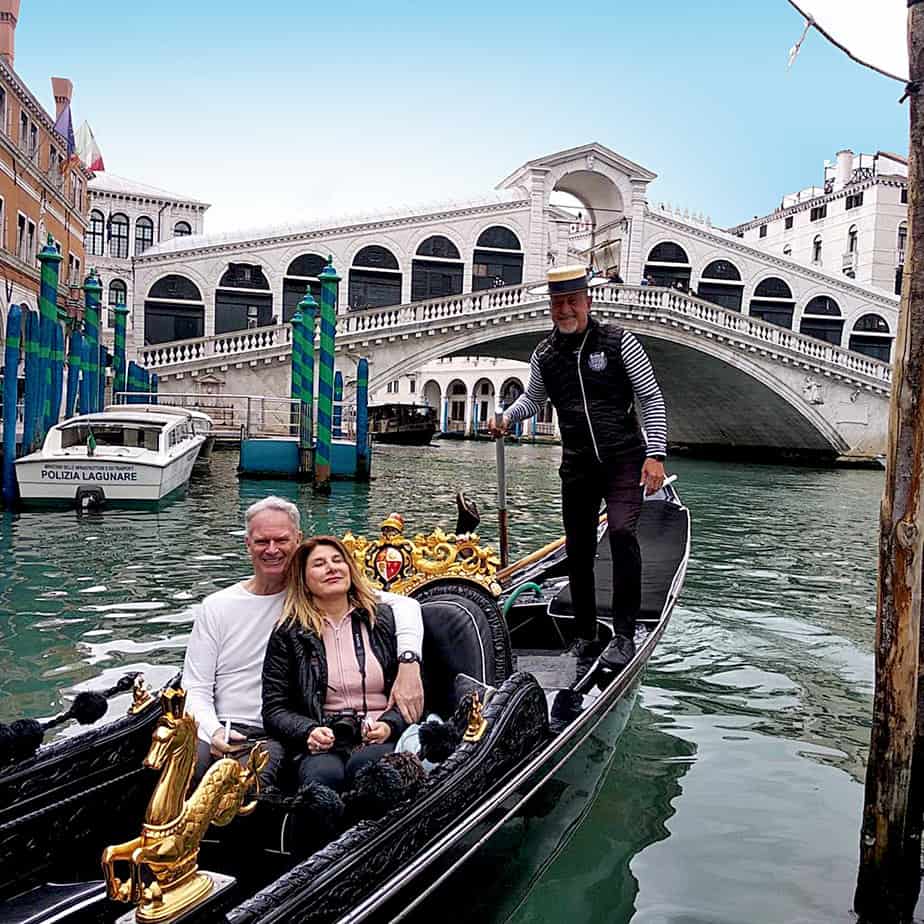
(This is the second of two parts.)
Italy’s 20 regions are like its pasta. They have so many different shapes, tastes and uses. And all are delicious.
I’ve been to 19 of the 20 (little Valle d’Aosta is still to go) and last week I wrote about half of them, in alphabetical order. This week I’m doing the second 10. They’re short and sweet thumbnail sketches with a few cryptic remarks based on personal experience thrown in.

The beauty of Italy’s regions is that for centuries they have had their own culture. Italian unification in 1861 didn’t change that. Crossing a border is like crossing into another country. The landscape changes. The cuisine changes. Even the language changes.
And Italy has so much more to see than the tourist quadrangle trail of Milan-Venice-Florence-Rome. How about the most magnificent cable car in the world? Or explore the largest active volcano in Europe? We’re expecting record tourist numbers here in Italy but you can always escape the crowds. Hopefully this blog will help. I added links to previous blogs on specific subjects.

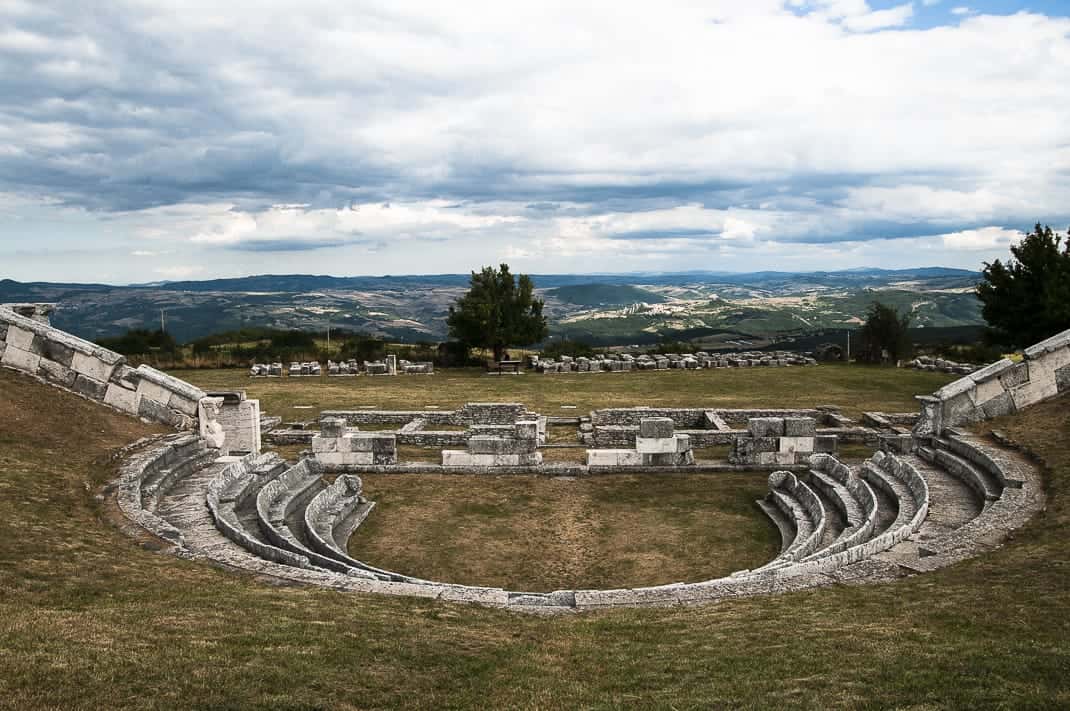
Molise (pop. 305,000)
This is the perfect place to get off the beaten path and escape Italy’s summer heat. It is the second-smallest region next to Valle d’Aosta and the least visited with only 482,051 making the journey in 2018. Squeezed along the Adriatic by Puglia and Abruzzo, Molise is 55 percent mountains and farmland make up most of the rest. Mass exodus after World War II has left Molise sparsely populated; little tourism history has left it lightly explored. Quaint villages, a coastline and an underrated capital make it worth the trip. But drive. Hitchhiking is faster than the available public transportation.
Biggest town: Campobasso (Pop. 49,000). Italians don’t think much of Molise’s lone example of a metropolis, but I like it. It’s only 40 miles from the sea and has a nice centro storico with windy cobblestone alleys. Sit in tree-lined Piazza Vittorio Emanuele II at one of the many outdoor cafes then wander the side streets for some Molisano cuisine you’ll have difficulty finding around the rest of Italy.
Best town: Pietrabbondante (pop. 740). You can drive into the hills 20 miles (30 kilometers) northwest of Campobasso and explore a theater complex that has been around since the Roman Republic. The Samnites, an agricultural people dating back before the Romans, built it in the 2nd century B.C. You can see remains of a 2,500-seat theater and two temples. The 3,169-foot (966 meters) elevation makes for a cool day trip.
Best site: The Tratturi. Central Italy is crisscrossed by 1,860 miles (3,100 kilometers) of trails shepherds have used to herd sheep since pre-Roman times. Molise is covered with them. UNESCO’s World Heritage Committee has recognized it but it might help hikers to recognize it if the tourist office had maps which we couldn’t find.
Most famous food: Caciocavallo di Agnone. While caciocavallo is also prevalent in neighboring Puglia, Molise’s version is among the most famous in Southern Italy. It’s aged in stone caves for three months and locals grill it with local bread.
Most famous wine: Tintila. It’s a rich red wine high in alcohol and dominated by flavors of plums and sour cherries (according to my wine guide as I didn’t have a clue.)
Most famous citizen: Pope Celestine V (born in Sant-Angelo Limosano, 1215-1296). Contrary to popular belief, it’s not actor Robert De Niro. His great grandparents are from Ferrazzano, just outside Campobasso. Not De Niro. He was born and raised in New York. Pope Celestine V was a hapless and weak pope who tired of the masses shrugging off his decrees and quit in disgrace after only five months in 1209. The rest of Molise’s most famous all left town.


Piedmont (pop. 4.4 million)
My favorite wine region in the world offers more than just endless tastings in cute villages inside sprawling vineyards. Its capital, Turin, is vastly underrated even if its famed Fiat (Fix It Again, Tony) is not. The Italian Alps can be seen for hundreds of miles and some of Italy’s best skiing isn’t far from Turin. And how can you not love Piedmontese cuisine? The Slow Food movement began here.
Biggest town: Turin (pop. 890,000). The Fiat factories in Turin (Not Torino. Only call it Torino when speaking Italian – unless, of course, you don’t know another Italian word.) has earned it the nickname the Detroit of Italy. Italians, obviously, have never visited Detroit. Turin is a stately city of big piazzas, is home to arguably Italy’s best chocolate and some of its most fascinating architecture. The needlepointed Mole Antonelliana is a must see museum for Italy’s famed movie industry.
Best town: Barolo (pop. 715). I write this with extreme prejudice as I’ve developed a love for Barolo wine bordering on snobbery. Located 45 miles (70 kilometers) south of Turin, this village is surrounded by vineyards that produce what many (including myself) consider the best red wine in the world. The village has a cute old town, including a three-level wine museum in a 10th century castle.
Best site: Museo Egizio. Opened in Turin’s beautiful Palazzo dell’Accademia delle Scienze in 1824, it has the largest collection of Egyptian items outside Cairo. They include a statue of Ramses II and 500 items from the tomb of famed architect Kha and his wife Merit dating back to 1400 B.C. A €50 million renovation was completed in 2015.
Most famous food: Truffles. These are the famous – and criminally expensive – mushrooms dug out of the ground by specially trained pigs attracted to the pungent aroma. They are grated over dishes, blended into pasta sauce and made into oil. Frankly, truffles taste like gorgonzola left out on a Rome sidewalk all summer but people buy them, even the white ones for €600 for 100 grams (3.5 punches). Black truffles are more affordable.
Most famous wine: Guess. Barolo, of course. Made from 100 percent Nebbiolo grapes, the wine comes from the grapes of 11 villages in Le Langhe, the region in southern Piedmont. So good, I firmly believe 1000 cases of it would end the war in Ukraine in 48 hours.
Most famous citizen: Vittorio Emanuele II (Turin, 1820-1878). He’s Italy’s father. He fought in the first Italian War of Independence and became Italy’s first king when he united the collection of city states in 1861. Every city, town and hamlet in Italy has a street named Vittorio Emanuele II.

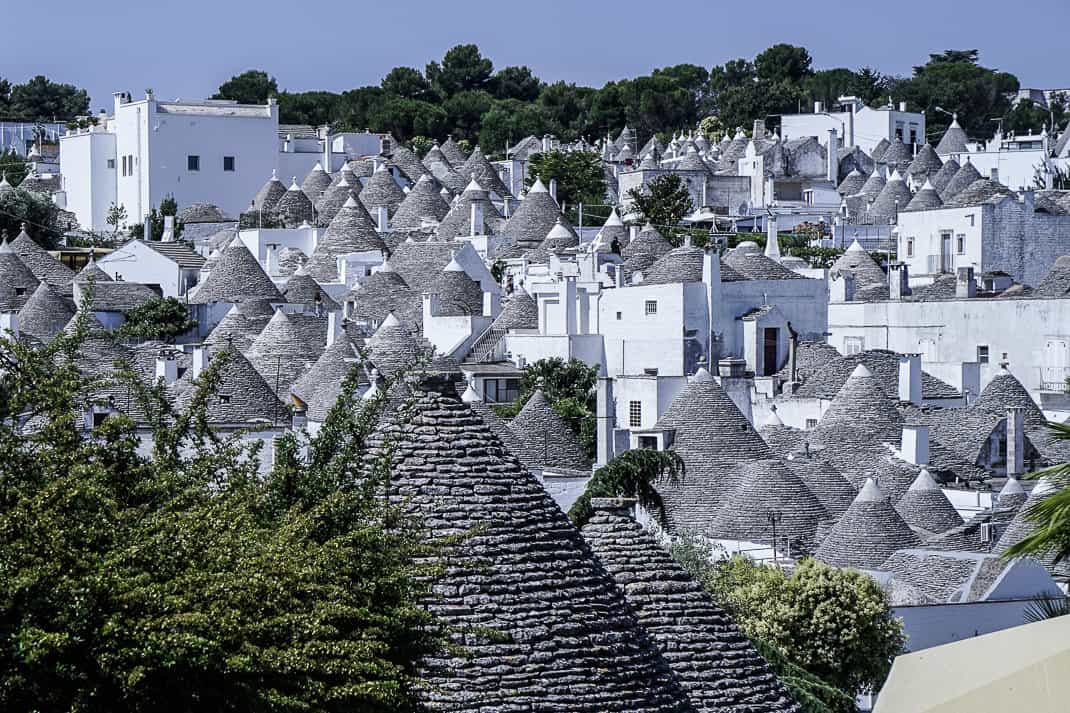
Puglia (pop. 4 million)
More Americans have discovered the heel of Italy’s boot and it has been a magnet for Italian tourists for years. The 480 miles (800 kilometers) of coastline are covered in fine golden sand (and, unfortunately, lawn chairs) and the hinterland has a quiltwork of farms growing some of Italy’s best produce. From Parco Nazionale del Gargano in the north to the heel’s tip of Salento, Puglia combines beach paradise with fascinating history and unique architecture.
Biggest town: Bari (320,000). It gets a bad rap as a shady port town where you catch ferries to Greece, Albania and Croatia but it it’s smack dab on the Adriatic Sea. The seafood is excellent and so is the street food. Bari’s old town is famous for its authenticity and it boasts the bones of St. Nicholas, also known as Santa Claus, in its Basilica di San Nicola.
Best town: Lecce (pop. 95,000). Known as the Florence of the South, Lecce is one of the prettiest towns in Italy. It’s overflowing with Baroque architecture, topped by the Basilica di Santa Croce, a weird mix of conventional Baroque work and stonemasons run amok. Hang out in the Piazza del Duomo where locals hid during invasions as the roads leading to the piazza are conveniently and charmingly narrow.
Best site: The trulli. The town of Alberobello has 1,500 of these small, snow-white dwellings with the pointy, stone roofs covering two hills. The UNESCO World Heritage Site was used by farmers up to the 14th century and some locals still live in them. They are offered for the night, too. But go early. It’s a major tourist trap. Tour buses clog the parking lots; souvenir shops line the streets. But it’s terrific if you want a pointy paperweight.
Most famous food: Orecchiette. The ear-shaped pasta used in dishes all over Italy originated in Bari in the Middle Ages. It forms Puglia’s most famous dish, orecchiette e cime di rapa (orecchiette with broccoli and turnips). The Orecchiette Festival has been held in Vignacastrisi near Lecce for the last 30 years. The dates are Aug. 8-9.
Most famous wine: Primitivo. It’s a big-flavor red wine great with heavy dishes. Try it with chicken cacciatore and lamb. It even goes great with pizza. But American pizza doesn’t go great with it, or anything else for that matter.
Most famous citizen: Aldo Moro (Maglie, 1916-78). One of the most popular prime ministers in Italian history, he ruled from 1963-68 and 1974-76. His economic and social reforms modernized Italy. He became the father of the center-left movement but wasn’t left enough for the far left Red Brigades who kidnapped him on March 16, 1978. They demanded he release 16 Red Brigade prisoners and after negotiations failed, on May 9 they shot him 10 times.


Sardinia (pop. 1.6 million)
You fancy yourself as an Italian jetset wannabe? Hang out at Costa Smeralda and sweet talk your way onto a yacht. (First, invest in designer shades.) You’re a nature lover and want unspoiled countryside with ancient architecture? Check out the Nuraghe. If you just want to live longer, move here. Anthropologists say Sardinia’s local products and low-stress lifestyle contributes to some of the oldest people on earth. I know. I visited the town of Tiana where five of the 646 residents were at least 100 years old.
Biggest town: Cagliari (pop. 154,000). Its relaxed vibe is highlighted by Piazza Yenne, lined with shady trees and outdoor cafes. Climb the steep stairs up to Il Castello, the historic neighborhood where the Spanish hanged ornery locals who had at least had great views of the sea as their last sights. This capital also has a good, sandy beach at Calamosca a short cab ride from the city center.
Best town: Alghero. (Pop. 44,000). Located on the west coast and controlled by the Spanish in the 14th century, some locals still speak with a Spanish accent. In fact, the defensive walls, three towers and narrow alleys leading to the centro storico makes Alghero resemble Seville. It’s an ideal base for Stintino, just 25 miles (45 kilometers) to the north and my favorite beach in Italy.
Best site: The Nuraghe. The Nuraghi were shepherds led by warrior kings and who inhabited Sardinia starting in 1800 B.C. They built more than 10,000 stone, conical edifices used for everything from residences to religious temples. To this day, 7,000 are scattered around the island.
Most famous food: Su Porceddu. In Sardo dialect that means “suckling pig.” It’s flavored with rosemary and roasted on a spit for five hours. Also popular is horse and donkey, although they’re harder to fit on a spit.
Most famous wine: Cannonau. It’s made from the Grenache grape, found all over the island. Cannonau has been associated with the Sardis’ longevity but after drinking too much of the deep red wine at 18 percent alcohol, the highest of any Italian wine, I barely saw my next birthday.
Most famous citizen: Grazia Deledda (Nuoro, 1871-1936). Only second woman to receive the Nobel Prize for Literature after her depiction of life on Sardinia in 1926.
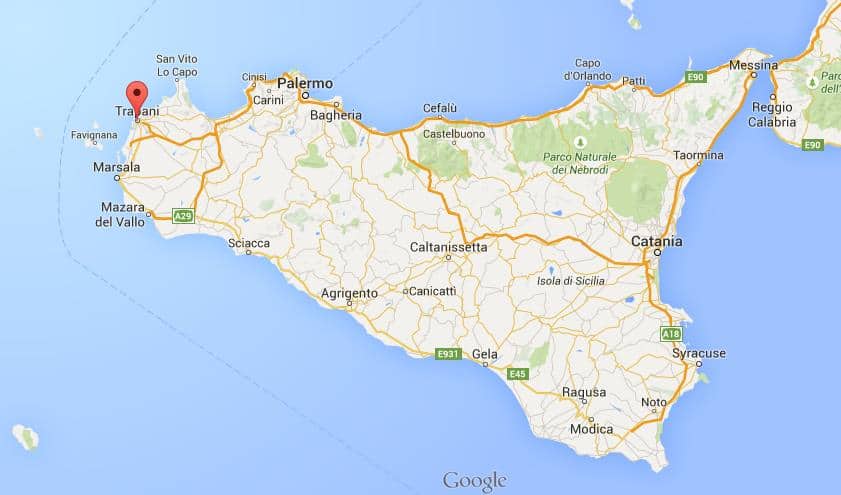
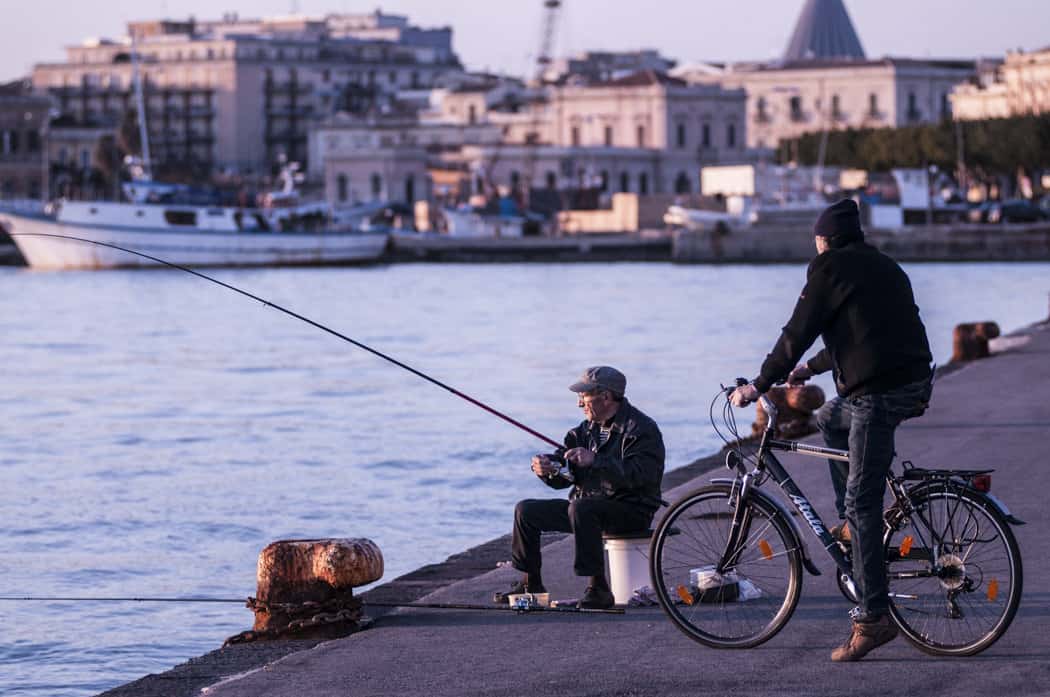
Sicily (pop. 5 million)
It’s more than mystery and history although those two themes have filled dozens of books and movie reels. Beaches ring the 1,150 miles (1,850 kilometers) of coastline and that doesn’t include the numerous islands that dot the Mediterranean around it. Feel free to inject your sweet tooth with a steady diet of cannolis and granitas while gazing at one of the greatest collections of Baroque architecture in Italy. And don’t worry about understanding Sicilians. The rest of Italy doesn’t understand them, either.
Biggest town: Palermo (pop. 675,000). It’s a combination of Italy and North Africa with Arabic-style domes and its crowded marketplaces. About 30 years ago, this was a dangerous town where the Cosa Nostra ruled in broad daylight. No more. Now the notorious Ballaro neighborhood is where I went for a good authentic meal and a fun time with the friendly locals. This city pulses with energy, charm and multiple cultures.
Best town: Syracuse (pop. 122,000). When the Corinthians settled Syracuse in 734 B.C., it was considered the most beautiful city in the Greek Empire. Today it’s one of the prettiest in Italy. Located on the southeast corner of Sicily, its neighborhood of Ortygia occupies a teardrop of an island off the mainland and is a wild maze or narrow alleys. People can still see concerts at the amphitheater in the Parco Archeologico della Neapolis.
Best site: Mt. Etna. The largest active volcano in Europe stands 10,900 feet (3,326 meters) and can often be seen with smoke billowing out of its crater. It has erupted 11 times since 2000, the latest last month when spewing ash over Catania cancelled flights. Tours involving hiking and all-terrain vehicles can be organized to the craters for the mentally deranged.
Most famous food: Cannoli. One of Italy’s favorite desserts dates back to the 9th century when the ruling Arabs served them in their harems. Today, any pasticceria worth its license fills the hard crusted pastry dough cone with fresh ricotta cheese by order. For Sicily’s best, go to Crocci, about six miles east of Trapani.
Most famous wine: Nero d’Avola. You will struggle to find a restaurant in Italy that doesn’t serve Sicily’s trademark red wine. It’s the house wine on the island and is exported all over the world. It’s versatile and goes with everything from lasagna to burgers.
Most famous citizen: Paolo Borsellino (Palermo, 1940-92). The Italian judge and prosecutor dedicated his career to overthrowing Sicily’s Cosa Nostra crime syndicate. It culminated in the Maxi Trial where 338 mafiosi were sentenced to a combined 2,665 years plus sentences given to 19 bosses. On July 19, 1992, six months after the appeals were denied, Borsellino was killed by a car bomb near his mother’s home.
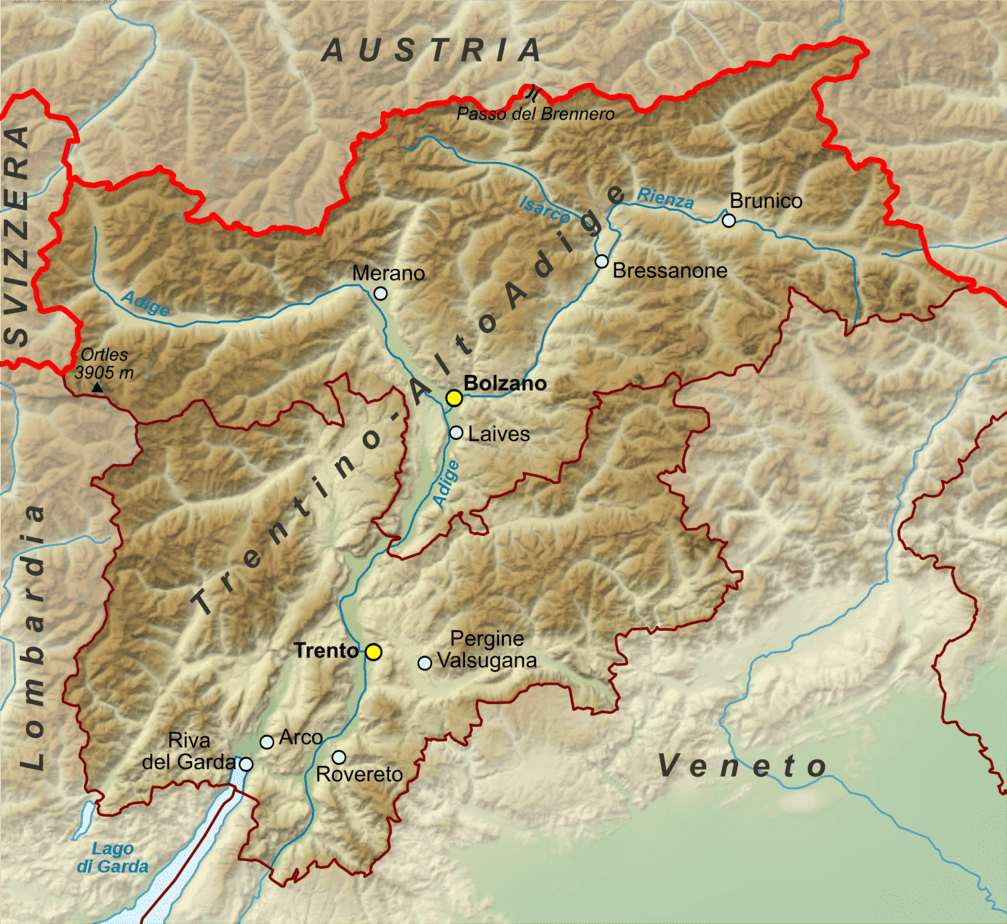

Trentino-Alto Adige (pop. 1.1 million)
If you don’t speak Italian but know some German, you’ll do fine in this bilingual region bordering Austria. Formerly territory of Austria, Trentino-Alto Adige still feels like Austria. The bilingual signs, hiking and climbing culture, diet staples of schnitzel and knodel, transportation that runs on time, it’s Italian in primarily border location only.
Biggest town: Trento (pop. 117,000). Located conveniently only 50 miles (90 kilometers) north of Lake Garda, Trento sits in a valley next to massive Dolomites. It’s the ideal base for cycling, hiking, climbing and skiing. Oh, don’t forget wine tasting.
Best town: Bolzano (pop. 106,000). This is one of the richest towns in Italy and its spotless streets and pastel-colored buildings make it look like an Austrian theme park. A good public transportation system, including cable cars, can whisk you up into the mountains and get you back down for some of the best German-style restaurants south of Munich. This is an excellent place to rent bikes.
Best site: Dolomites. These majestic pointy mountains, looking like giant icy stalagmites, stretch all the way into the Veneto region. They are both beautiful and dangerous, the last destination for many a climber. But they are also speckled with posh ski resorts and feature 227 miles (365 kilometers) of hiking trails.
Most famous food: Knodel. Also known by the Italian name Canederli, knodel is the German word for dumpling. They are made from stale bread, flour, milk and egg and served in a rich broth or dry with melted butter and grated cheese or speck (cured pork).
Most famous wine: Sparkling. The high altitudes and cold climate are perfect ingredients for Italy’s best bubbly, fruity wines. Look for the labels Ferrari and Cavit and you can tour the Ferrari factory in Trento.
Most famous citizen: Reinhold Messner (Bressanone, 1944-). Widely considered the world’s greatest mountaineer, he was the first to climb Everest without oxygen (with Austrian Peter Habeler) in 1978, the first to solo Everest in 1980 and the first to climb all 14 peaks over 8,000 meters (26,000 feet), also without oxygen. Oh, yes. In his spare time, he walked across Antarctica, Greenland and the Gobi Desert alone without public transport.
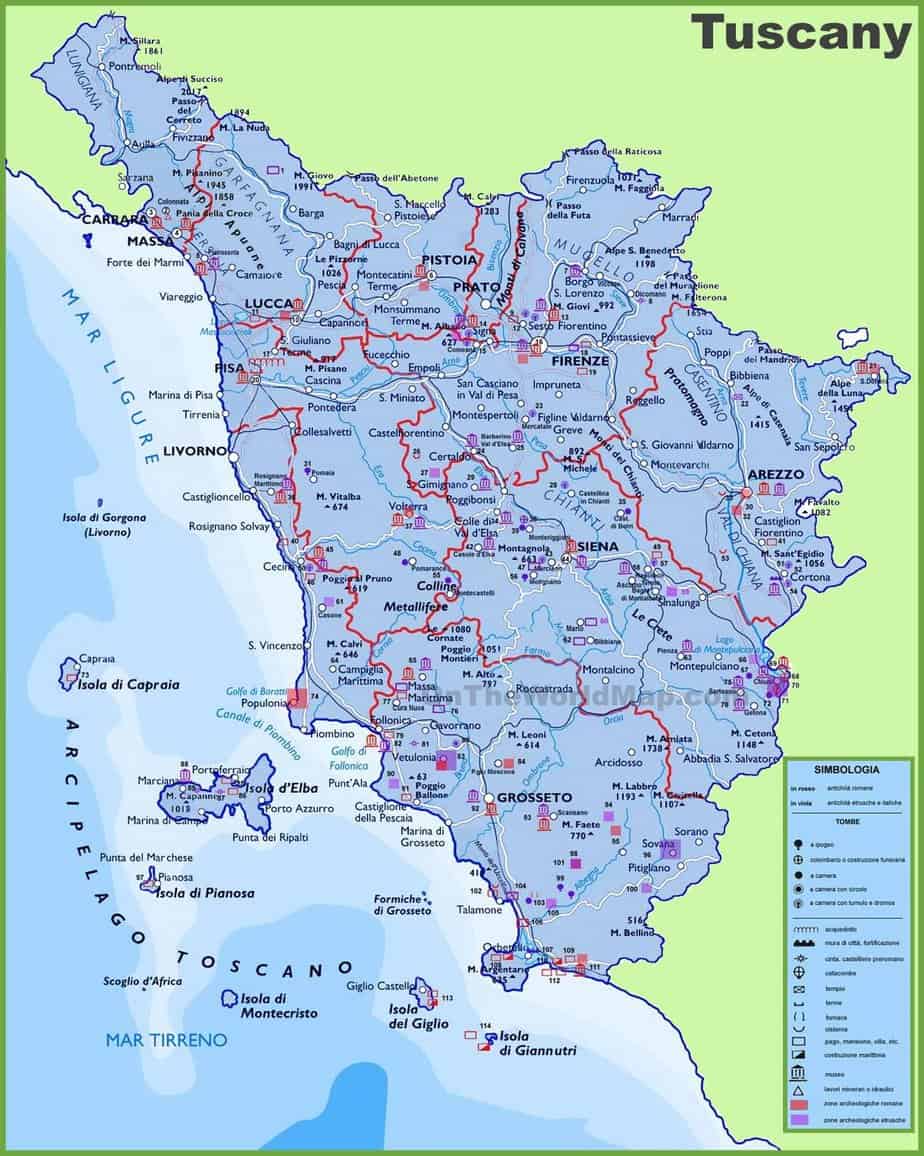

Tuscany (pop. 3.7 million)
If you’ve dreamed of Italy, sipping Chianti looking out over a vast quilt of vineyards stretching to the horizon probably crossed your mind. Or watching the sun set from Florence’s Ponte Vecchio or strolling through the Uffizi, possibly the greatest art museum on Earth. It was the center of the Renaissance and remains a symbol of all things artsy in Italy.
Biggest town: Florence (pop. 380,000). This is no day trip. You must dive into the rich collection of art deeper than the Arno River that cuts majestically through town. Between the Uffizi, with its collection of Michelangelos and Raphaels and Da Vincis, and the Galleria dell’Accademia, housing the world’s most famous sculpture, David, Florence has enough art to blister your eyes.
Best town: Lucca (pop. 88,000). This is also more than a day trip. Take a morning to walk the 2 ½ miles (4 kilometers) atop the best Renaissance fortification walls in Europe. Inside is a charming historical center where you can drink nearly every Tuscan wine you want while sitting in the oval-shaped Piazza dell’Anfiteatro.
Best site: Uffizi. Florence’s trademark museum houses the greatest collection of Italian Renaissance art in the world. Housed in the beautiful 16th century, U-shaped Palazzo degli Uffizi, this museum has an entire room for Michelangelo and two for Caravaggio, including his famed Head of Medusa. Yes, it’s crowded. Go early. Or go twice.
Most famous food: Bistecca alla Fiorentina. Being an American, I know steak. Being a resident of Italy for 9 ½ years, I know Florence’s steak is one of the three best I’ve ever had. It’s Italy’s version of the T-bone steak and served as 1-1.5-kilogram (2.2-3.3-pound) slabs.
Most famous wine: Chianti. The Chianti region in western Tuscany has produced Chianti wine since the 14th century. So versatile. So fruity. So good. It made the Sangiovese grape famous. Careful, though. Regular Chianti can be a bit dull. Look for Chianti Reserva or Chianti Superiore.
Most famous citizen: Leonardo da Vinci (Anchiano, 1452-1519). Sorry, Michelangelo. You were his match as an artist but Da Vinci was also a genius at architecture, astronomy, science, math and anatomy. He learned that when a man sits, the distance from his seat to the top of his head will be half his height. He studied that just to paint more accurately. Plus, unlike Michelangelo, Da Vinci bathed.
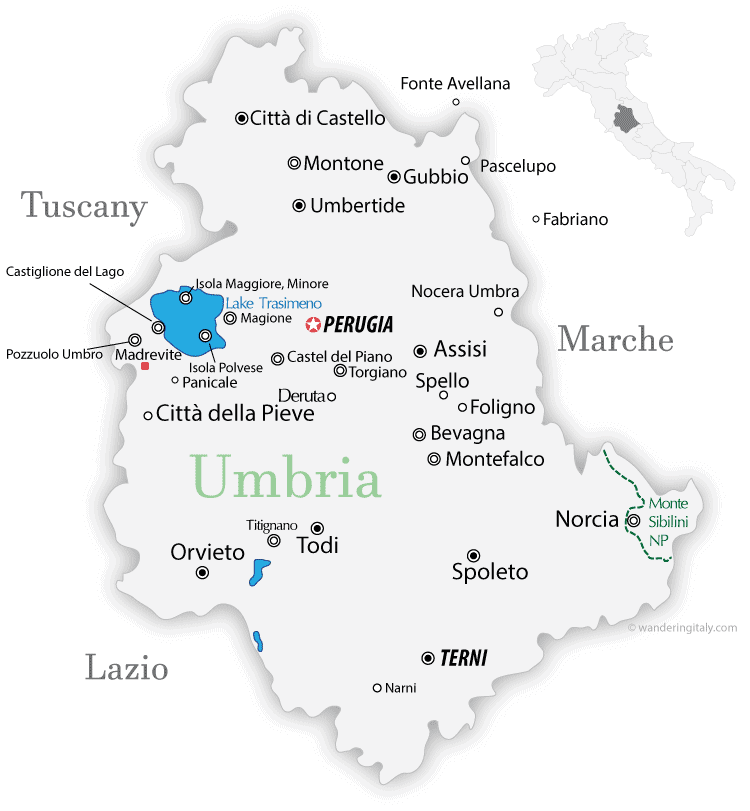

Umbria (pop. 880,000)
Italy’s only landlocked region (besides Lilliputian Valle d’Aosta), Umbria is the least influenced by outside sources. It scores points for authenticity and for the lower number of tourists savvy enough to explore the walled hill towns few knew before arriving. Rolling farmland is the perfect backdrop for leisurely drives ending with a glass of underrated Umbrian wine and wild game meat, ranging from pigeon to cinghiale (wild boar).
Biggest town: Perugia (pop. 160,000). Trying to kick a chocolate habit? Avoid Umbria. It’s the home of Perugini chocolates and the annual EuroChocolate fest. Its historical center is reached by a collection of dark escalators through eerily lit tunnels. With a major student population, its nightlife rocks.
Best town: Orvieto (20,000). Umbria’s jazz capital sits atop a volcanic rock overlooking vineyards and olive groves. Its white marble Duomo took 300 years to build and is one of the prettiest in Italy. Orvieto has a haunting past. The Orvieto Underground consists of 440 caves used as bomb shelters during World War II.
Best site: Basilica di San Francesco. It has dominated a hill overlooking Assisi and since the 13th century. The bell tower, the archaic porticoes and the sweet singing from Franciscan monks as you stroll the church makes you feel close to God even if you don’t believe in one
Most famous food: Porchetta. The famous pork meat originated in Lazio but it’s celebrated like an edible god in Umbria. It is savory, suckling pig stuffed with rosemary, garlic and fennel and cooked over a spit for six to eight hours. It differs from Sardinia’s Su Porceddu as porchetta has a crispy skin and meat that melts in your mouth. Umbria has the annual Porchettiamo festival.
Most famous wine: Sagrantino di Montefalco. Umbria’s most important DOCG wine, it’s thick with red fruit and made from the Sagrantino grape which is only grown in Umbria. It’s an Umbrian tradition for a new grandfather to buy 12 bottles of a vintage and save it for 25 years until the grandchild marries.
Most famous citizen: St. Francis (Assisi, 1181-1228). Son of a wealthy silk merchant, Francis renounced all wealth and dedicated his life to helping animals and the poor. He founded the order of Franciscans and would be useful today in helping the homeless mob in the California town named for him.
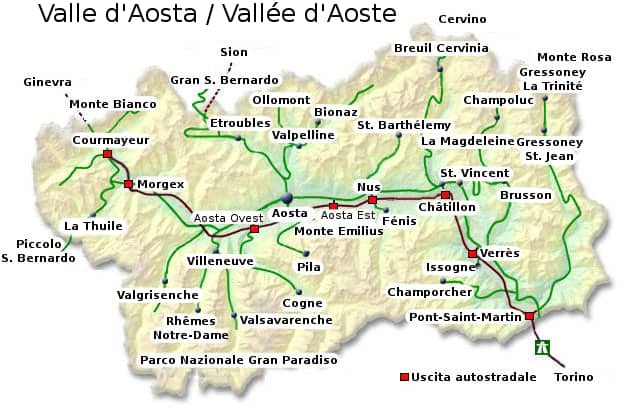
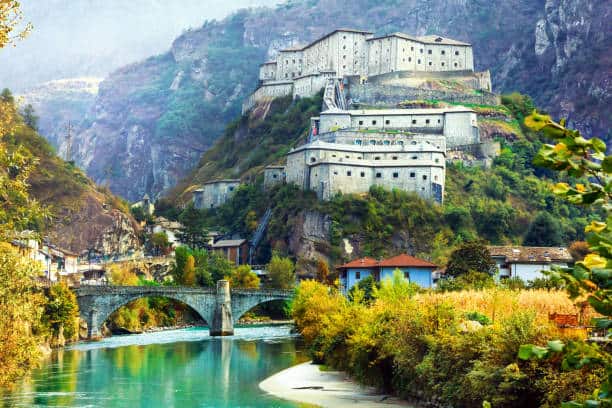
Valle d’Aosta (pop. 125,000)
Full disclosure. This is the only region I have not visited but I’ve heard a lot. Italy’s smallest region is tucked in Italy’s northwestern corner bordering Switzerland and France with the emphasis on French. One glacier runs across this region that is only three-quarters the size of Rhode Island but only about one-tenth the population. Yet from there you can see the famous peaks of Mont Blanc and the Matterhorn.
Biggest town: Aosta (pop. 34,000). Surrounded by Alpine peaks, this tidy capital has a cute historical center and a strange local Valdostan dialect that’s almost musical. French is widely spoken here.
Best town: Courmayeur (pop. 2,800). Right on the French border, this is the base for climbing Mont Blanc or hitting the area’s high-end ski resorts. Its sister sitter across the border is famous Chamonix.
Best site: Funivie Monte Blanco. Considered the world’s most magnificent cable car, this engineering marvel that opened in 2015 goes three-quarters up Mont Blanc, the highest mountain in Western Europe. It then crosses numerous glaciers before descending into France.
Most famous food: Fonduta. That means fondue. In Valle d’Aosta it’s made from the area’s Fontina cheese and enriched with egg yolks. Traditionally you only dip bread in it but in this valley they also use steamed green vegetables and potatoes.
Most famous wine: Valle d’Aosta. No, this isn’t produced by the tourist office. Despite the wine’s generic name, the region boasts 400 wine growers who work with Petit Rouge, Nebbiolo and Pinot Nero grapes in the highest vineyards in Europe.
Most famous citizen: Anselm of Canterbury (Aosta, 1033-1109). Considered one of the greatest philosophers of the Middle Ages, as Archbishop of Canterbury he pushed back against English kings William II and Henry I. Shortly after his death he was canonized as a saint.
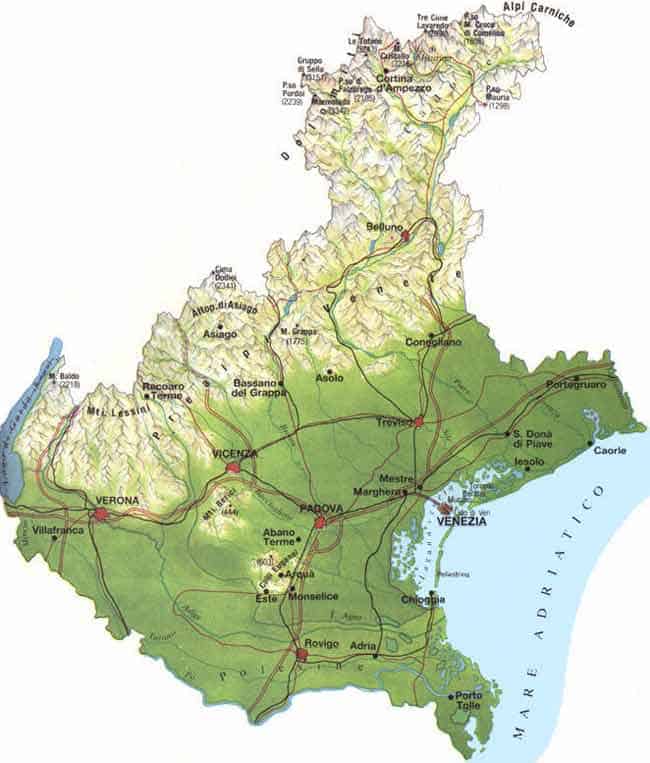

Veneto (pop. 4.9 million)
There is more to Veneto than Venice – and many Venetians have discovered that by deserting the overrun tourist haven. Still, this region’s open maw of an archipelago on the Adriatic is worth exploring with the back canals of the Lido lightly trodden. Small inland cities such as Padua, Verona and Treviso all retain their individuality from when they were city states in the shadow of the Venetian Republic.
Biggest town: Verona (pop. 255,000). This place is so romantic, no wonder it’s where Romeo hit on Juliet. The 1st century Roman amphitheater still puts on strong performances, including a summer opera festival. And sometime in your life, attend Vinitaly, the world’s largest public wine exposition held every April.
Best town: Venice (pop. 50,000). By the time you finish reading this graph, it may be down to 49,000. No matter. Go anyway. Everyone should experience a large (at least, at one time) city without cars. Get away from the Grand Canal and you can find pockets of peace and quiet you’ll never find anywhere else.
Best site: St. Mark’s. Go early — way early — and catch Venice’s iconic 9th century basilica before it’s overcome with flesh and elbows. Be sure to take a tour of its prison. Pass over the Bridge of Ahs, named because the magnificent Grand Canal was the last thing prisoners saw before they were locked away.
Most famous food: Seppia. That means “cuttlefish.” It tastes a bit like calamari but the black ink the fish spews from its ink gland turns any dish into something resembling a dare. Served over pasta or polenta, it isn’t nearly as bad as it looks.
Most famous wine: Amarone. It rivals Barolo as Italy’s best red wine and is definitely one of the best in the world. It’s made from Corvina, Corvinone and Rondinella grapes grown north of Veneto. If you’re shopping, bring your credit card.
Most famous citizen: Marco Polo (Venice, 1254-1324). Traveled Asia’s Silk Road in the 13th century and was the first to expose the Far East to Europeans. Also served as Kublai Khan’s foreign emissary which sent him throughout Southeast Asia.


June 28, 2023 @ 11:09 am
Thank you for putting it together. It’s a nice quick reference guide and I learned somethings. Now I know why the Piazza in Polignano a Mare is named Aldo Moro. I hope to visit all regions.